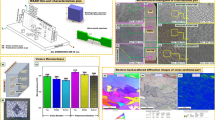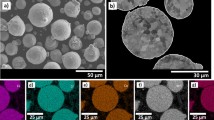Abstract
Microstructure evolution and properties of a Cu–Cr–Ag alloy during the continuous manufacturing process were investigated in detail by scanning electron microscopy (SEM) and transmission electron microscopy (TEM) in the study. The Cu–Cr–Ag alloy rod with uniform compositions is fabricated by upward continuous casting technology. Few of the Cr phases are observed in the as-cast alloy. During the continuous extrusion process, the severe shear deformation and the dynamic aging occur. The average grain size of as-extruded alloy is much smaller than that of as-cast alloy. Both fcc and bcc Cr precipitates appear in the matrix. The interaction mode between dislocations and precipitates can be identified as Orowan bypass mode according to the TEM observations. The overall difference in the yield strength between as-cast and as-extruded Cu–Cr–Ag alloy is attributed to solid solution strengthening, grain refinement strengthening, precipitation hardening and working hardening.








Similar content being viewed by others
References
Hatakeyama M, Toyama T, Yang J, Nagai Y, Hasegawa M, Ohkubo T, Eldrup M, Singh BN. Nanostructural evolution of Cr-rich precipitates in a Cu–Cr–Zr alloy during heat treatment studied by 3 dimensional atom probe. Mater Trans. 2008;49(3):518.
Cheng JY, Shen B, Yu FX. Precipitation in a Cu–Cr–Zr–Mg alloy during aging. Mater Character. 2013;81:68.
Li MM, Zhang XP, Chen HM, Wang H, Yang B. Microstructure evolution and mechanical properties of Cu–Cr–In alloy during thermo-mechanical treatment. Chin J Rare Met. 2017;41(12):1311.
Liu Q, Zhang X, Ge Y, Wang J, Cui JZ. Effect of processing and heat treatment on behavior of Cu–Cr–Zr alloys to railway contact wire. Metall Mater Trans A. 2006;37:3233.
Pang Y, Xia CD, Wang MP, Li Z, Xiao Z, Wei HG, Sheng XF, Jia YL, Chen C. Effects of Zr and (Ni, Si) additions on properties and microstructure of Cu–Cr alloy. J Alloys Compd. 2014;582:786.
Xia CD, Zhang W, Kang ZY, Jia YL, Wu YF, Zhang R, Xu GY, Wang MP. High strength and high electrical conductivity Cu–Cr system alloys manufactured by hot rolling–quenching process and thermomechanical treatments. Mater Sci Eng A. 2012;538:2951.
Wang ZQ, Zhong YB, Cao GH, Wang C, Wang J, Ren WL, Lei ZS, Ren ZR. Influence of dc electric current on the hardness of thermally aged Cu–Cr–Zr alloy. J Alloys Compd. 2009;479(1–2):303.
Huang FX, Ma JS, Ning HL, Geng ZT, Lu C, Guo SM, Yu XT, Wang T, Li H, Lou HF. Analysis of phases in a Cu–Cr–Zr alloy. Scr Mater. 2003;48(1):97.
Cheng JY, Yu FX, Shen B. Solute clusters and chemistry in a Cu–Cr–Zr–Mg alloy during the early stage of aging. Mater Lett. 2014;115:201.
Zhang Y, Volinsky A, Tran HT, Chai Z, Liu P, Tian BH, Liu Y. Aging behavior and precipitates analysis of the Cu–Cr–Zr–Ce alloy. Mater Sci Eng A. 2016;650:248.
Li HQ, Xie SH, Mi XJ, Wu PY. Phase and microstructure analysis of Cu–Cr–Zr alloys. J Mater Sci Technol. 2007;23(6):795.
Chbihi A, Sauvage X, Blavette D. Atomic scale investigation of Cr precipitation in copper. Acta Mater. 2012;60(11):4575.
Correia JB, Davies HA, Sellars CM. Strengthening in rapidly solidified age hardened Cu–Cr and Cu–Cr–Zr alloys. Acta Mater. 1997;45(1):177.
Hatakeyama M, Toyama T, Yang J. 3D-AP and positron annihilation study of precipitation behavior in Cu–Cr–Zr alloy. J Nucl Mater. 2009;386–388:852.
Jin Y, Adachi K, Takeuchi T, Suzuki HG. Ageing characteristics of Cu–Cr in situ composite. J Mater Sci. 1998;33(5):1333.
Peng LJ, Xie HF, Huang GJ, Xu GL, Yin XQ, Feng X, Mi XJ, Yang Z. The phase transformation and strengthening of a Cu-0.71 wt% Cr alloy. J Alloys Compd. 2017;708:1096.
Batra IS, Dey GK, Kulkarni UD, Banerjee S. Precipitation in a Cu–Cr–Zr alloy. Mater Sci Eng A. 2002;356(1–2):32.
Zhao ZQ, Xiao Z, Li Z, Ma MZ, Dai JJ. Effect of magnesium on microstructure and properties of Cu–Cr alloy. J Alloys Compd. 2018;752:191.
Chihiro W, Ryoichi M, Kazue T. Mechanical properties of Cu–Cr system alloys with and without Zr and Ag. J Mater Sci. 2008;43(3):813.
Li HQ, Xie SS, Mi XJ, Liu Y, Wu PY, Chen L. Influence of cerium and yttrium on Cu–Cr–Zr alloys. J Rare Earth. 2006;24(1):367.
Liu Q, Cui ZJ, Xu GM, Liu XT. Experimental study of Cu–Ag alloy contact wire manufactured through upward-casting process. J Northeast Univ. 2004;25(9):844.
Zhang ZG. Study on high conductivity and high strength copper–silver alloy wire and new continuously manufacturing techniques. Zhengzhou: Zhengzhou University; 2013. 19.
Yuan Y, Li Z, Xiao Z, Zhao ZQ, Yang ZQ. Microstructure evolution and properties of Cu–Cr alloy during continuous extrusion process. J Alloys Compd. 2017;703:454.
Sun J, Liu P, Liu XK, Chen XH, He DH, Ma FC, Li W. Microstructure evolution and properties of Cu–Ni–Si alloy during continuous extrusion process. Chin J Nonferr Met. 2014;24(4):944.
Thomas BM, Derguti F, Jackson M. Continuous extrusion of a commercially pure titanium powder via the conform process. Mater Sci Technol. 2017;33(7):899.
Yuan Y, Li Z, Xiao Z, Zhao ZQ. Investigations on voids formation in Cu–Mg alloy during continuous extrusion. JOM. 2017;69(9):1696.
Liu Y, Li Z, Jiang YX, Zhang Y, Zhou ZY. The microstructure evolution and properties of a Cu–Cr–Ag alloy during thermal-mechanical treatment. J Mater Res. 2017;32(7):1324.
Freudenberger J, Lyubimova J, Gaganov A. Non-destructive pulsed field CuAg-solenoids. Mater Sci Eng A. 2010;527(7–8):2004.
Lei Q, Li Z, Zhu A, Qiu WT, Liang SQ. The transformation behavior of Cu–8.0Ni–1.8Si–0.6Sn–0.15Mg alloy during isothermal heat treatment. Mater Charact. 2011;62(9):904.
Mabuchhi M, Higashi K. Strengthening mechanisms of Mg–Si alloys. Acta Mater. 1996;44(11):4611.
Hansen N. Hall–Petch relation and boundary strengthening. Scr Mater. 2004;51(8):801.
Han K, Vasquez AA, Xin Y, Kalu PN. Microstructure and tensile properties of nanostructured Cu–25wt% Ag. Acta Mater. 2003;51(3):767.
Wang SC, Zhu Z, Starink MJ. Estimation of dislocation densities in cold rolled Al–Mg–Cu–Mn alloys by combination of yield strength data, EBSD and strength models. J Microsc. 2005;217(2):1.
Shintani T, Murata Y. Evaluation of the dislocation density and dislocation character in cold rolled Type 304 steel determined by profile analysis of X-ray diffraction. Acta Mater. 2011;59(11):4314.
Wen H, Topping TD, Isheim D, Seidman DN, Lavernia EJ. Strengthening mechanisms in a high-strength bulk nanostructured Cu–Zn–Al alloy processed via cryomilling and spark plasma sintering. Acta Mater. 2013;61(8):2769.
Acknowledgements
This study was financially supported by the National Key R&D Program of China (No. 2016YFB0301400) and the National Natural Science Foundation of China (No. 51601017).
Author information
Authors and Affiliations
Corresponding author
Rights and permissions
About this article
Cite this article
Xu, GL., Peng, LJ., Huang, GJ. et al. Microstructural evolution and properties of a Cu–Cr–Ag alloy during continuous manufacturing process. Rare Met. 40, 2213–2220 (2021). https://doi.org/10.1007/s12598-019-01238-x
Received:
Revised:
Accepted:
Published:
Issue Date:
DOI: https://doi.org/10.1007/s12598-019-01238-x




